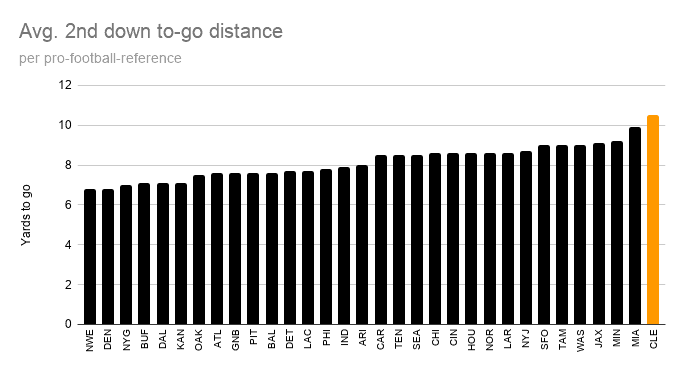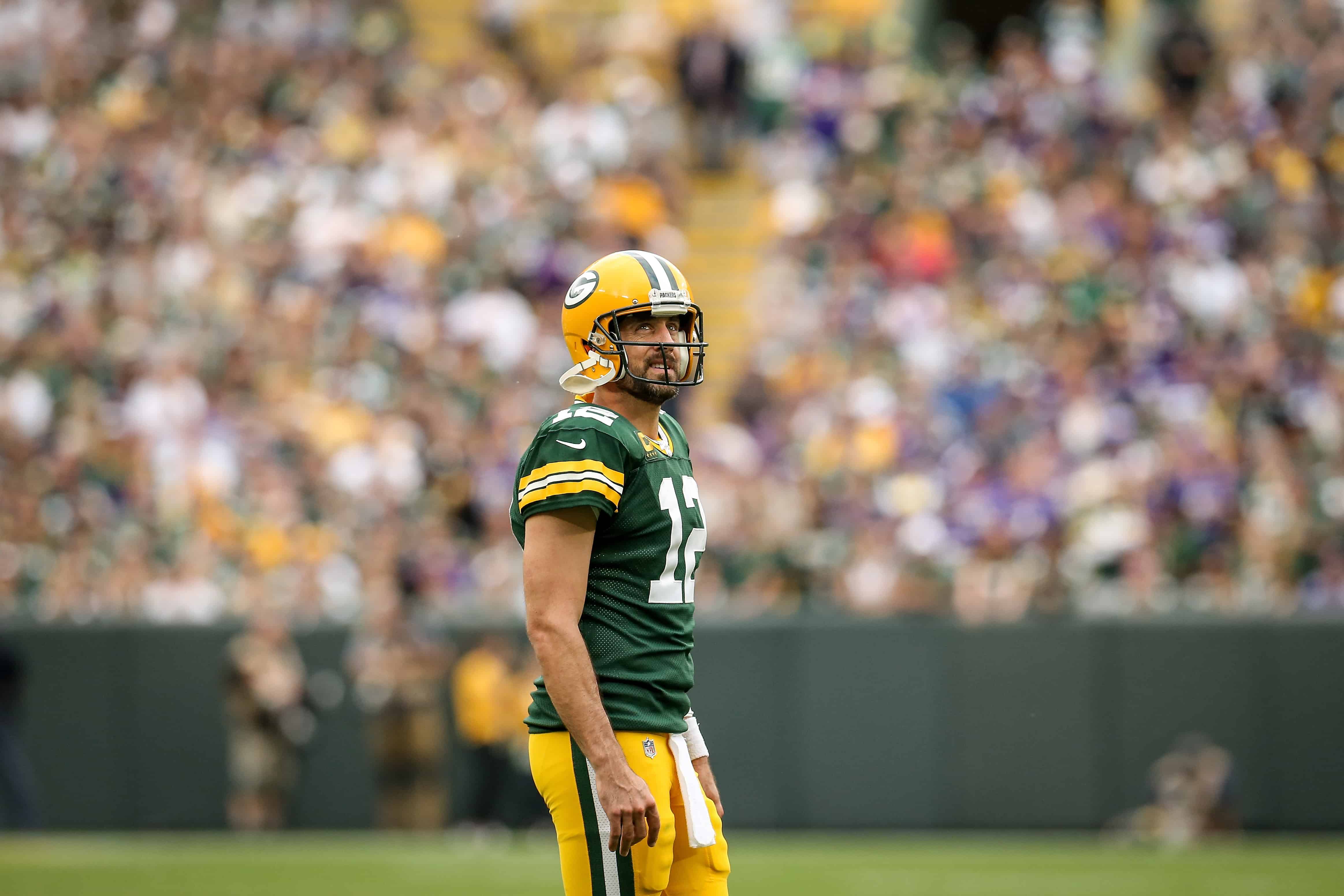Offensive change was all over the NFL during the offseason. 15 teams headed into 2019 under the first full year of a new play-caller on offense. There was a wide range of expectations among those teams, but two offenses that generated the most excitement were the Green Bay Packers, moving from Mike McCarthy to Matt LaFleur, and the Cleveland Browns, who handed the keys to Freddie Kitchens after a successful second-half of the season in 2018.
Through two weeks of the season, neither offense has lived up to those lofty expectations. Green Bay ranks 26th in offensive DVOA and Cleveland ranks 27th. Both teams have been lifted by impressive defenses that have helped prevent an early-season hole that might have been too difficult to climb. The Packers defense is third in DVOA, while the Browns are 10th.
When highlighting the Packers’ defense after the opening Thursday Night Football game, we mentioned how that type of defensive performance can help as the offensive works itself into a rhythm as the season progresses. That’s certainly worked for the 2-0 Packers and it’s helped the 1-1 Browns. But what about those offenses? Are these cases of new systems needing time or are there more reasons for concern than just the slow starts?
Green Bay Off-Script
Noting the Packers’ offensive DVOA rank might be overselling the performance of the offense through two games. Green Bay ranks 31st in yards per drive (better than only the Miami Dolphins) and 29th in points per drive. The Packers also average the most punts per drive and only the New York Jets have gone three-and-out more often. That’s not the type of production you’d expect from an Aaron Rodgers-led offense, especially without McCarthy.
But maybe this slow start shouldn’t be surprising, given the circumstances. Rodgers played zero snaps in the preseason, which gave no opportunity for the quarterback and head coach to mesh in game situations, other than a few joint practices, which Rodgers openly detested.
It’s been a growing trend to point out Rodgers’s production over the past few seasons hasn’t been near what his reputation as one of the league’s best quarterbacks would suggest. Rodgers’s numbers have been down — his minus-0.06 EPA per attempt (26th among 37 quarterbacks) and 36.1 QBR (24th of 32) this year certainly don’t help — but looking a little deeper, Rodgers’s play hasn’t been the problem so far.
The Packers, to this point, have done a good job of getting Rodgers and the passing offense in a groove early. They’ve been one of the best teams at scripting effective passing plays early in the game. The problem, though, is that effectiveness hasn’t carried deeper into games. Rodgers and the Packers have averaged 9.3 yards per attempt in the first quarter but that drops to 5.5 YPA in the second quarter and then to an astounding 3.7 YPA in the third quarter before it goes back up to 7.5 in the fourth. There’s certainly a small sample here and Rodgers’s 3.7 YPA in the third quarter isn’t going to be predictive of what’s to come, but it’s certainly descriptive of what’s happened so far.
Against the Minnesota Vikings in Week 2, the Packers started the game with a play-action pass that hit Davante Adams for 39 yards. Later in the first quarter, Rodgers hit another deep pass to Adams for 21 yards. Rodgers didn’t have another completion on a pass that traveled at least 15 yards in the air for the remainder of the game, but that wasn’t really on him.
Here’s a play to start the fourth quarter on a 3rd-and-6. Marquez Valdes-Scantling was pushed to the ground as the point of a trips bunch. Rodgers bought time and allowed Valdes-Scantling to get back up and run down the field. Rodgers threw a pass that went right into his receiver’s hands, but the defensive back was just close enough to punch it out. It’s a tough catch in that situation for a receiver, but it’s also an impressive throw from the quarterback.
Rodgers has been impressive on throws like that this season, but hasn’t come up with the completions to make it look like the case. Those completions are coming, though. Per Sports Info Solutions’s on-target percentage (defined as a catchable pass), Rodgers has been one of the most accurate deep and intermediate throwers in the league, despite a low completion percentage.
Perhaps the biggest disconnect for the Packers is where Rodgers has excelled in accuracy and where most plays have developed. Some of this is also still based on Rodgers’s insistence on trying to find the big play down the field. Many of his off-target throws in the “short” area of the field come from his throwaways when Rodgers has scrambled and there is no deep option open. This is less of a problem in the earlier scripted plays but does progress as the game does when both Rodgers as a quarterback and LaFleur as a play-caller go off-script. However, as more of these accurate passes downfield turn into completions, the tradeoff of Rodgers waiting for them to open up will be much greater.
What the Packers have also done well is mix in play-action at a higher rate. So far Green Bay has used play-action on 27% of its passes, which ranks 12th in the league. Last season, they used play-action on just 20% of plays, which ranked 27th.
During the offseason, there was talk about Rodgers’s preference between under center and shotgun and how that would impact play-action. That hasn’t been an issue, instead, straight drop backs have been the biggest problem, where the Packers average just 4.7 yards per play. That should turn and the Packers could even limit that impact by using more play-action. The top teams are nearing 40% play-action, such as LaFleur’s previous team, the Tennessee Titans, at 36%.
Especially given the lack of playing time the starting offense had together during the preseason, it’s much too soon to write this offense off. There are still a number of positive indicators going forward. Continuing the momentum from the first scripted plays into the adjustments further into the game should come as Rodgers and LaFleur get more comfortable with each other. The deep shots will continue to come and connect more often.
Browns in a rush
Things haven’t gone quite as smoothy in Cleveland, where if you didn’t see the jerseys would have thought the New York Giants were playing against the Jets in MetLife Stadium this past Monday night — sloppy play, too many runs, and a bailout from a huge Odell Beckham catch and run.
Through two games the Browns are 26th in both yards per drive and points per drive. The season started with a clunker against the Tennessee Titans, then the offense also struggled for much of what should have been a runaway win against the New York Jets. The underlying metrics in Cleveland aren’t as promising, though.
One place where the Browns could easily improve is penalties. This has been the most penalized team in the league through two weeks (27 penalties against, the next team is at 20). 12 of those penalties have come on offense. What has been a killer is when those penalties come on first down and because of it, the Browns have killed themselves on second down. They’re the only team in the league that averages more than 10 yards to go on second down this season.

Cleveland has also been one of the most run-heavy teams on first down with a 52% run rate, the 10th highest rate in the league.
Being consistently behind the sticks has caused Baker Mayfield to force some plays. Against both the Titans and Jets, Mayfield has shown a combination of holding onto the ball too long then rushing his throws, causing them to be inaccurate.
Per Next Gen Stats, Mayfield has a Rodgers-esque 3.07 average seconds to throw (Rodgers is at 3.1). That’s part better protection than given credit for (both the Packers and Browns rank favorably by ESPN’s Pass Block Win Rate) and part running around hoping for something better to open up. The issue with Mayfield is those rush throws after the running around that turn into long incompletions.
Take this throw against the Jets on a 3rd-and-6. The Jets show pressure with seven, but only end up rushing four. Mayfield has room in the pocket, but awkwardly steps up into his pass and sails the ball over an open Beckham’s head.
Accuracy was one of Mayfield’s best qualities coming out of college and as he improved during his rookie year, but that hasn’t completely shown up in 2019.
So far in 2019, the short area of the field has been Mayfield’s biggest weakness. It also happens to be where most of his pass attempts have been thrown. That’s a spot that should seem fixable with some easy passes on early downs with schemed openings.
The Browns also have yet to fully unleash what could be accomplished with play-action. Cleveland has used play-action on just 17% of pass plays, which ranks 24th. So far the play-action game has worked quite well when it’s been called; Cleveland’s 9.9 yards per play ranks 12th in the league.
Using play-action and getting Mayfield more involved on first down are things we expected from this Browns offense, but neither has really happened through two games. Both could be key to getting Mayfield more comfortable in the pocket early in games, which could, in turn, help the accuracy issues by limiting the number of rushed throws.
There’s still a tremendous amount of talent on the offensive side of the ball and the Browns do have the “Beckham slant in case of emergency” option they whipped out on Monday night. Just two weeks into the season, there’s plenty of time for everything to come together and it all starts with getting the quarterback in the best position to succeed. And if the Browns start to click in Week 3, it’s still a five-week head start on what they had to endure in 2018.
















